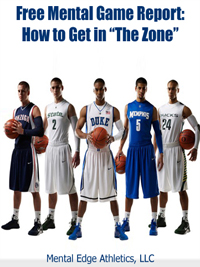Feedback in Athletic Coaching: Is Educating Coaches the Missing Link?
 There is extensive research in the area of feedback in athletics that is of tremendous practical value to coaches. However, coaches are not being educated in the theories of feedback nor are they implementing skills that have been discovered by researchers, psychologists, and sports scientists. In the business world, research and development laboratories pass on this knowledge to professionals to further their companies. In the world of athletics, qualified sports psychologists and fellow coaches qualified in the area of feedback must pass on this knowledge by presenting research and offering their advice.
There is extensive research in the area of feedback in athletics that is of tremendous practical value to coaches. However, coaches are not being educated in the theories of feedback nor are they implementing skills that have been discovered by researchers, psychologists, and sports scientists. In the business world, research and development laboratories pass on this knowledge to professionals to further their companies. In the world of athletics, qualified sports psychologists and fellow coaches qualified in the area of feedback must pass on this knowledge by presenting research and offering their advice.
Feedback and communication in general are critical components to coaching. Feedback allows coaches to tell athletes how they are performing in relation to their expectations. Coaches can then instruct and teach their athletes how to reach these expectations and perform better (Hillman, Schwandt & Bartz, 1990). Thus, feedback and coaching are interdependent but not the same.
Coaches, as do all people who are socially adjusted, extract cues from their environment to better function in the world. Coaches base their expectations of their athletes on personal and performance cues. Personal cues can include gender, physical appearance, and ethnicity. Performance cues can range from previous training and game performances to fitness testing (Solomon, 1999; DiMarco, Ohlson & Solomon, 1998). These initially constructed mental schemas of their athletes can influence the “type, amount, and quality of feedback issued. When coach perceptions of an athlete are consistently communicated and understood by the athlete they can impact the athlete’s future performance and psychological growth in a positive or negative manner” (DiMarco et al., 1998).
Expectancy Theory, also known as the Self-Fulfilling Prophecy Effect and Pygmalion Effect, can have exceedingly positive or negative effects on an athlete or team. Coaches’ form initial opinions and expectations of their athletes based on cues. Coaches’ expectations are communicated to athletes through verbal or non-verbal feedback. If an athletes’ performance confirms the coaches’ preconceived notions the cycle continues (Solomon, 1999).
Expectancy theory almost always plays a role in team dynamics due to differential feedback. Differential feedback occurs primarily due to coaches’ perceptions of differences in athletic ability (DiMarco et al., 1998; Solomon, 1999; Solomon & Kosmitcki, 1996, Solomon et al., 1996). However, it can also be a result of diversity of ethnicities and academic abilities (Solomon, 1999, Solomon & Kosmitcki, 1996). High expectancy individuals, players who are expected to do well in sport, typically receive feedback in greater amounts and in higher quality. Athletes who are not anticipated to have much success, low expectancy athletes, receive more general instruction (Solomon & Kosmitcki, 1996; Solomon, 1999; DiMarco, 1998).
Expectancy theory and differential feedback creates an unequal playing field at the start of a playing season or training period. Research has shown that most coaches have “stable” perceptual flexibility (Solomon & Kosmitcki, 1996). Solomon & Kosmitcki (1996) studied intercollegiate basketball coaches and their perceptual flexibility by asking them to rank their players abilities and potential to improve at the beginning of the season and at the end. When Solomon & Kosmitcki (1996) compared the rankings at the end of the season, “the correlations suggest that the ability rankings of all players were quite similar.” This does not bode well for coaches altering their line ups as players improve or for recognizing significant technical or physical improvement in their athletes. The more perceptual flexibility a coach has the more ability they have to alter their feedback (Solomon & Kosmitcki, 1996).
John Wooden was a believer that differential feedback was a solution rather than a problem. Wooden was a legendary basketball coach of University of California Los Angeles (UCLA), and the only member of the basketball hall of fame as a player and a coach. He led his team to ten National Collegiate Athletic Association (NCAA) championships in twelve years.
“The ratio of positive to negative comments delivered to reserves favored praise, while it was roughly even for regulars . . . praising the reserves was intended to let them know he appreciated their role of helping regulars prepare for stiff competition . . . If he praised them more than the regulars, he hoped this would reinforce their commitment and effort” (Gallimore & Tharp, 2004, pp. 129-130).
Wooden believed that by knowing his players’ roles on his team and their personal needs he was doing the correct thing by altering his feedback. His feedback was intended to motivate them to stay on the team, give their full effort in practice, and remain engaged in the activity.
Wooden wrote that he was not always successful in motivating his reserves and that many of his players were upset by his feedback style. Many of Wooden’s reserves felt dissatisfied and unhappy with their experience. Wooden wrote years later about one reserve recalling, “There was one reserve player who avoided me for years, and finally (he) told me that he had felt I did not like him. I never had any feelings about [him] that was [sic] ill” (Gallimore & Tharp, 2004, p. 131). Low expectancy players often perceive their experiences as less positive than high expectancy players due to their coaches’ feedback (DiMarco et al., 1998).
John Wooden’s style is an example of one of the many methods of feedback that have been observed and researched. Gallimore and Tharp had the opportunity to observe the intricacies of Wooden’s coaching style during practice in a 1970 study in which his feedback was counted and categorized. This study was then revisited in 2004. The analysis revealed how Coach Wooden related to his player’s with very specific, short, and positive feedback. Of his total verbal communication, 50.3 percent were instructions to his players (Gallimore & Tharp, 2004). This instruction consisted of very concise statements spoken rapidly telling the players what they had done right or wrong. Wooden never spoke for long, “keeping his instructional statements brief was part of his instructional philosophy and approach . . . ‘Give a coach the opportunity to take fifteen minutes to say what he should in fifteen seconds—he will!’” (Gallimore & Tharp, 2004, p. 126). After collecting the data those observing were surprised that Wooden’s comments were not more positive and praise oriented as Wooden had professed to a belief in positive coaching.
When confronted with this data, Wooden explained that teaching correct techniques and skills rather than providing broad statements of praise is positive coaching. One of his former players agreed, “‘it was the ‘information’ I received, during the correction, that I needed most… Had the majority of Coach Wooden’s corrective strategies been positive (‘Good Job’) or negative (‘No, that’s not the way’,) I would have been left with an evaluation, not a solution” (Nater as cited in Gallimore & Tharp, 2004, p. 128). There have been other coaches studied with similar instructional or teaching styles, “Langsdorf (1979) observed Frank Kush, a successful collegiate football coach, and reported a 36% frequency of ‘instructing’. A study of Jerry Tarkanian, a celebrated basketball coach, reported three different forms of ‘instructing’ constituted 55% of his teaching (Bloom, Crumpton & Anderson, 1999) (Gallimore & Tharp, 2004, p. 121).
Although Wooden, Kush, and Tarkanian were instructing they often did so through questioning not telling. Questioning allows the athlete to think for themselves. The Guidance Hypothesis alerts coaches to causing dependency in their athletes. If a coach gives too much feedback to frequency the athlete will not be able to use self-introspection and identify mistakes during or after their practice or performance. Intermittent feedback and the use of questioning are best to facilitate thought and self-awareness (Salmoni et al., 1984 as cited in Baudry et al., 2006). Fading is another technique available to reduce dependency. Fading is the process of withholding feedback till the end of a practice or training session. Fading also increases the likelihood of athletes practicing error detection throughout the beginning and middle of practice as well as their desire to receive feedback (Mononen et al., 2003).
Feedback in Athletic Coaching Part 2
Rebekah Conway Roulier, Ed.M. is the General Manager of the Doc Wayne Athletic League, Inc. a 501 (c)(3) and is responsible for sports programs and training of coaches in current and future markets, the enhancement of the organization’s “do the good” (DtG) therapeutic curriculum and management of the monitoring and evaluation systems. She comes to Doc Wayne with an Ed.M. in Counseling with a Specialization in Sport Psychology and with extensive experience in coaching and work in youth services. Rebekah has a B.A. and Ed.M. from Boston University. In addition to her work at Doc Wayne, she has provided performance enhancement consultation to athletes, coaches and referees seeking “success” at a variety of levels.
References
Baudry, L., Leroy, D., Thouvarecq, R., & Choller, D. (2006). Auditory concurrent feedback benefits on the circle performed in gymnastics. Journal of Sport Sciences, 24.2.
Becker, A., & Wrisberg, C. A. (2008). Effective coaching in action: Observations of legendary collegiate basketball coach Pat Summitt. Sport Psychologist, 22(2).
Gladwell, M. (2008). Outliers. New York: Little, Brown and Company.
Hillman, L., Schwandt, D., & Bartz, D. (1990). Enhancing staff members’ performance through feedback and coaching. Journal of Management Development, 9(3), 20-27.
Le Foll, D., Rascle, O., & Higgins, N. (2008, March). Attributional feedback-induced changes in functional and dysfunctional attributions, expectations of success, hopefulness, and short-term. Psychology of Sport and Exercise, 9(2), 77-101.
Leszcz, M., & Yalom, I. D. (2005). The Theory and Practice of Group Psychotherapy. New York: Basic Books.
Lopez, S. J., & Snyder, C. R. (2007). Positive Psychology: The Scientific and Practical Explorations of Human Strengths. Thousand Oaks: Sage Publications, Inc.
Mouratidis, A., Vansteenkiste, M., Lens, W., & Sideridis, G. (2008, April). The motivating role of positive feedback in sport and physical education: Evidence for a motivational model. Journal of Sport & Exercise Psychology, 30(2), 240-268.
Solomon, G., Striegel, D., Eliot, J., & Heon, S. (1996, March). The self-fulfilling prophecy in college basketball: Implications for effective coaching. Journal of Applied Sport Psychology, 8(1), 44-59.
Sports Coach. (n.d.). Information Feedback – Exteroceptive, Proprioceptive ,Kinaesthetic.
Burke, K., Peterson, D., & Nix, C. (1995). The Effects of the Coaches’ Use of Humor on Female Volleyball Players’ Evaluation of Their Coaches. Journal of Sport Behavior , 18(2), 83-90.
DiMarco, A., Ohlson, C., Reece, S., & Solomon, G. (1998). Expectations and coaching experience: is more better?. Journal of Sport Behavior, 21.4.
Edward, H., & Landin, D. (1994). Effects of a learning model and augmented feedback on tennis skill acquisition. Research Quarterly for Exercise and Sport, 8.
Gallimore, R., & Tharp, R. (2004). What a Coach Can Teach a Teacher, 1975-2004: Reflections and Reanalysis of John Wooden’s Teaching Practices. The Sport Psychologist, 18, 119-137.
Kristal, N. (2005). Crossing the line: when does coaching go from constructive feedback to abusive criticism? (Spotlight on Acting Schools and Coaches). Back Stage West, 2.
Mononen, K., Viitasalo, J., Konttinen, N., & Pertti, E. (2003). The effects of augmented kinematic feedback on motor skill learning in rifle shooting. Journal of Sports Sciences, 10.
Rancourt, K. (1995). Real-time coaching boosts performance. Training & Development, 4.
Schunk, D. (n.d.). Try Harder? Motivational Effects of Effort Attributional Feedback. ERIC Digest.
Solomon, G., & Kosmitzki, C. (1996). Perceptual flexibility and differential feedback among intercollegiate basketball coaches. Journal of Sport Behavior, 15.
Unknown. (1972). Giving Feedback: Some notes on a general framework. Soc.-Psych, 26, 1-3.


























Hey! This is my first comment here so I just wanted to
give a quick shout out and tell you I genuinely enjoy reading your posts.
Can you recommend any other blogs/websites/forums that deal with the same subjects?
Thank you so much!
Hey Blake,
Check out our blog at https://www.myteamgenius.com/blog/ – we post tons of helpful youth sports content about player feedback and development, player evaluations, club management, and everything in between.